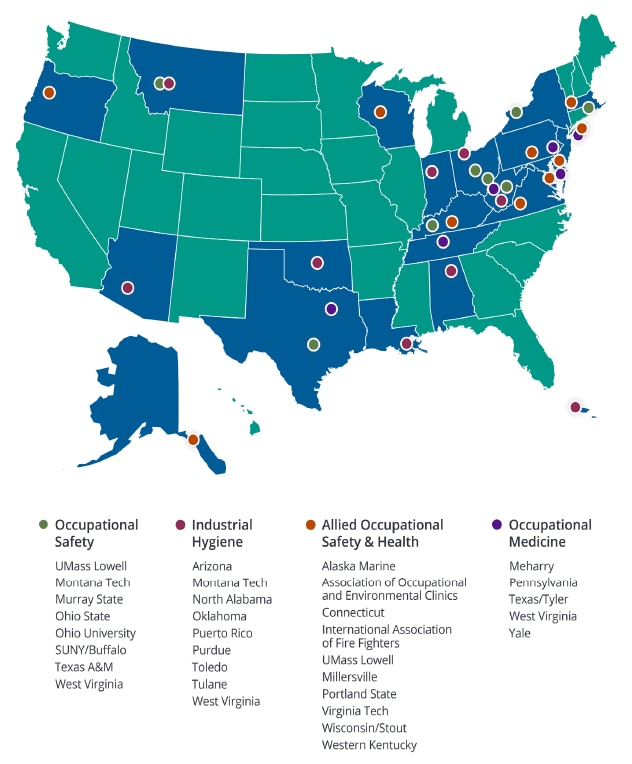FY 2020 Extramural Research Program Highlights: Training Programs
Specialty Training Programs
NIOSH funds the TPGs, the Commercial Fishing Occupational Safety Training Grants funded at the end of FY 2019, and the Miner Safety and Health Training Program—Western United States cooperative agreement. Selected highlights from TPGs and the Miner Safety and Health Training Program—Western United States are provided below.
On this page, you will research highlights for our:
- Training Project Grants
- Emergency Responder Training Program
- Miner Safety and Health Training Program
You can also find the information on this page in the NIOSH Extramural Research and Training Program: Annual Report of Fiscal Year 2020.
Training Project Grants
NIOSH supports training in occupational safety and health through TPGs. Most TPGs are academic training programs that support undergraduate, graduate, and post-graduate training. Located throughout the United States, these programs enrich the national network of graduate training the ERCs offer. Along with TPGs for traditional degree training programs, NIOSH supports TPGs that respond to the unique training needs of specialty groups. These include the Association of Occupational and Environmental Clinics’ Occupational Health Internship Program. This program supplies specialty training and increases diversity among health and safety practitioners by recruiting and mentoring students from underrepresented and underserved minorities.
Through a TPG, the Alaska Marine Safety Education Association expands the network of port-based fishing safety instructors in Alaska and the United States. They achieve this through a train-the-trainer curriculum designed for the unique needs of the commercial fishing industry. NIOSH also provides funding for the Emergency Responder Training Program through the IAFF, which this report later discusses.
NIOSH Training Project Grants by Discipline

Emergency Responder Training Program
Through the IAFF, NIOSH supports a nationwide program to enhance the capabilities of firefighters engaged in emergency response through training. The training is site- and trade-specific and aims to reduce on-the-job injuries, illnesses, and fatalities related to emergency response. Therefore, responders are better able to protect the communities they serve.
The IAFF has a long working relationship with NIOSH. IAFF’s Emergency Responder Training Program is part of a complete first responder training plan. IAFF’s teachings seek to improve knowledge, attitudes, and behaviors so that first responders adopt a safer approach to emergency response throughout their career. IAFF training is a resource that directly affects decisions firefighters make each and every day.
Miner Safety and Health Training Program
Despite many technological and work environment advances, mining remains one of the most demanding occupations in the United States. Because of the many challenges in the mining industry, the focus areas for mining training must cover a wide range of hazards and risks.
The Mine Safety and Health Administration (MSHA) Training Academy in Beckley, West Virginia, serves the mining community in the Eastern United States. Because this training program is not easy for miners in the Western States to access and certain aspects of mining operations differ in eastern and western operations, NIOSH has supported miner safety and health training in the Western United States since 1999.
For FY 2020, two programs were funded in the Western United States: the Colorado School of Mines and the University of Arizona. This training provides a joint approach to reducing occupational illnesses, injuries, and fatalities to miners and other workers in mining operations. It also aims to translate research into workplace practices that (1) improve mining safety, (2) advance the safety and health of miners, (3) enhance the safety and health of other workers involved in mining operations, and (4) increase the quantity of qualified mine safety and health trainers in the Western United States.
Several of the main objectives of the training program follow:
- To develop, deliver, and manage the training needs of miners in the Western United States.
- To provide qualified instructors and faculty.
- To start and carry out “train the trainer” courses.
- To evaluate training effectiveness and impact on reducing injuries and illnesses to miners.
- To coordinate with existing training programs, like those offered by MSHA and MSHA-funded state programs, and in partnerships with industry, miners, and other agencies.
NIOSH intends for the program’s training to be consistent with OSHA and MSHA guidelines, without duplicating these agencies’ existing trainings.
